MARIANI’S
Virtual Gourmet
June 17,
2018
NEWSLETTER
HAPPY FATHER'S DAY!
❖❖❖
IN THIS ISSUE
EATING AROUND ALGHERO, SARDINIA
By John Mariani
NEW YORK CORNER
BEN & JACK'S STEAKHOUSE
By John Mariani
NOTES FROM THE WINE CELLAR
WHAT (I HOPE) I'M DRINKING FOR FATHER'S DAY
By John Mariani
❖❖❖
EATING AROUND
ALGHERO, SARDINIA
By John Mariani
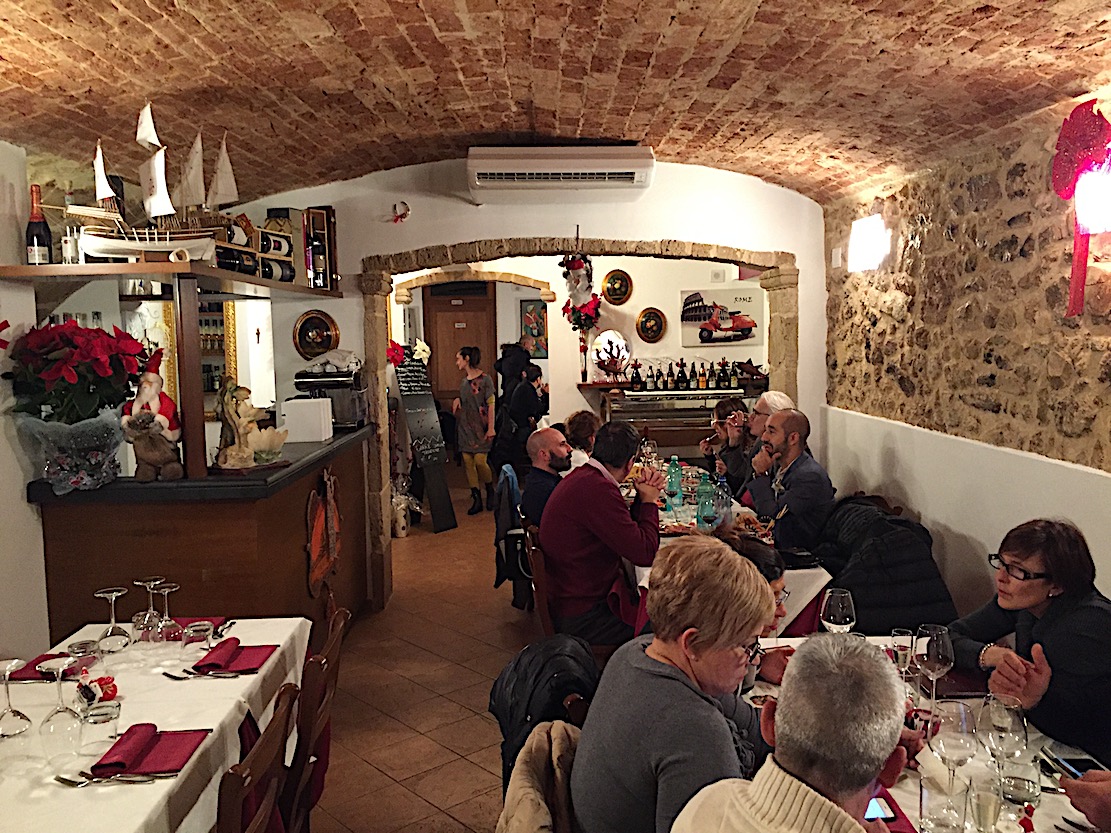
Trattoria Marco Polo, Alghero
The circumference of
the volcanic island of
Sardinia, all 1,149 miles of it, is a series of
scooped out scallops, with
bays, shoals and inlets, crab-like claws of land
and offshore juttings of
massive rock structures pushed up from the
Western Mediterranean. To the north
is Corsica, to the east the Tyrrhenian Sea and
Sicily, to the south the edge of
Africa. Such a location would seem to make
Sardinia central to the export of
Mediterranean seafood, yet there is no
large-scale seafood industry on the
island, whose economy is devoted overwhelmingly
to livestock and agriculture.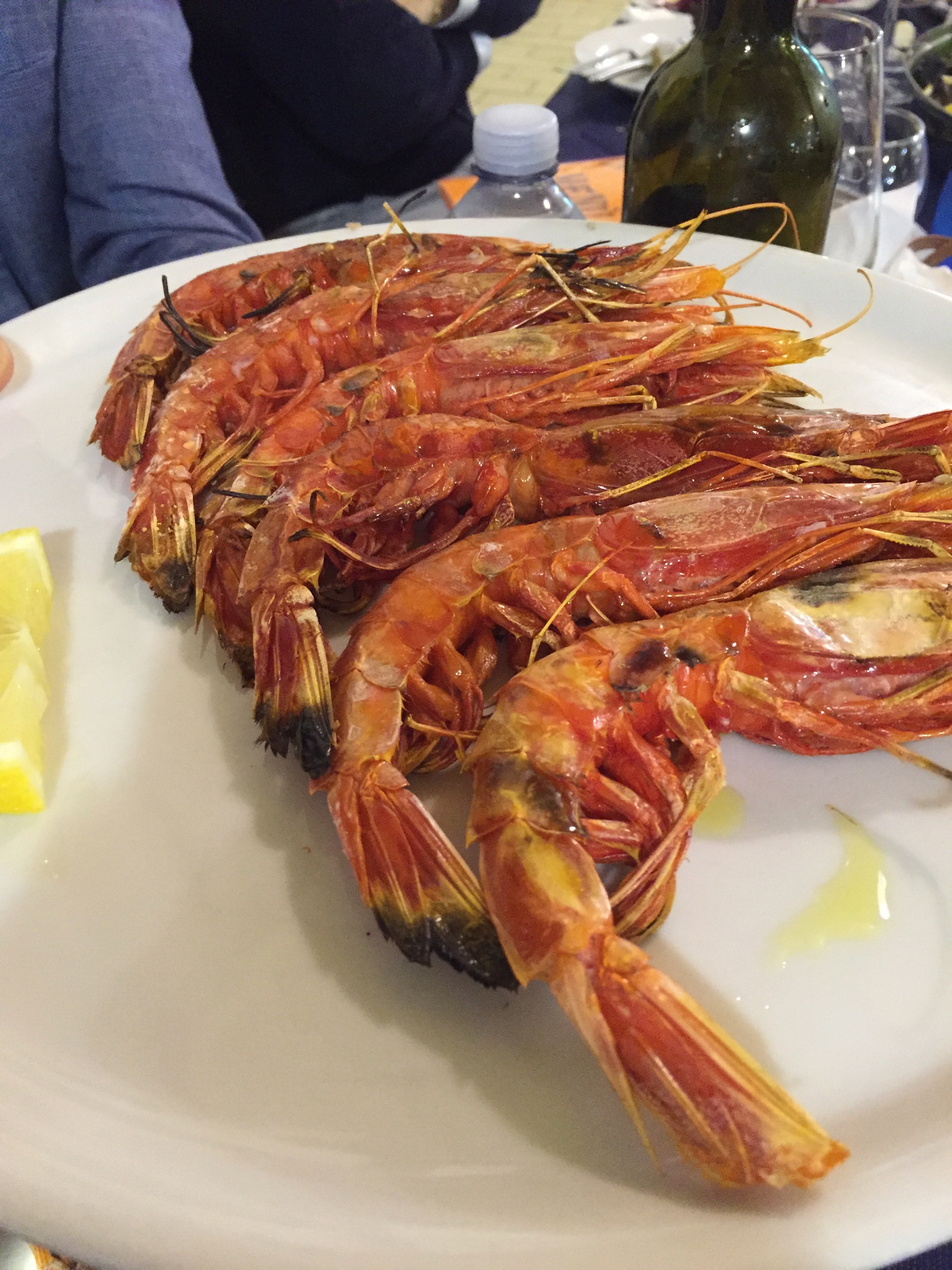
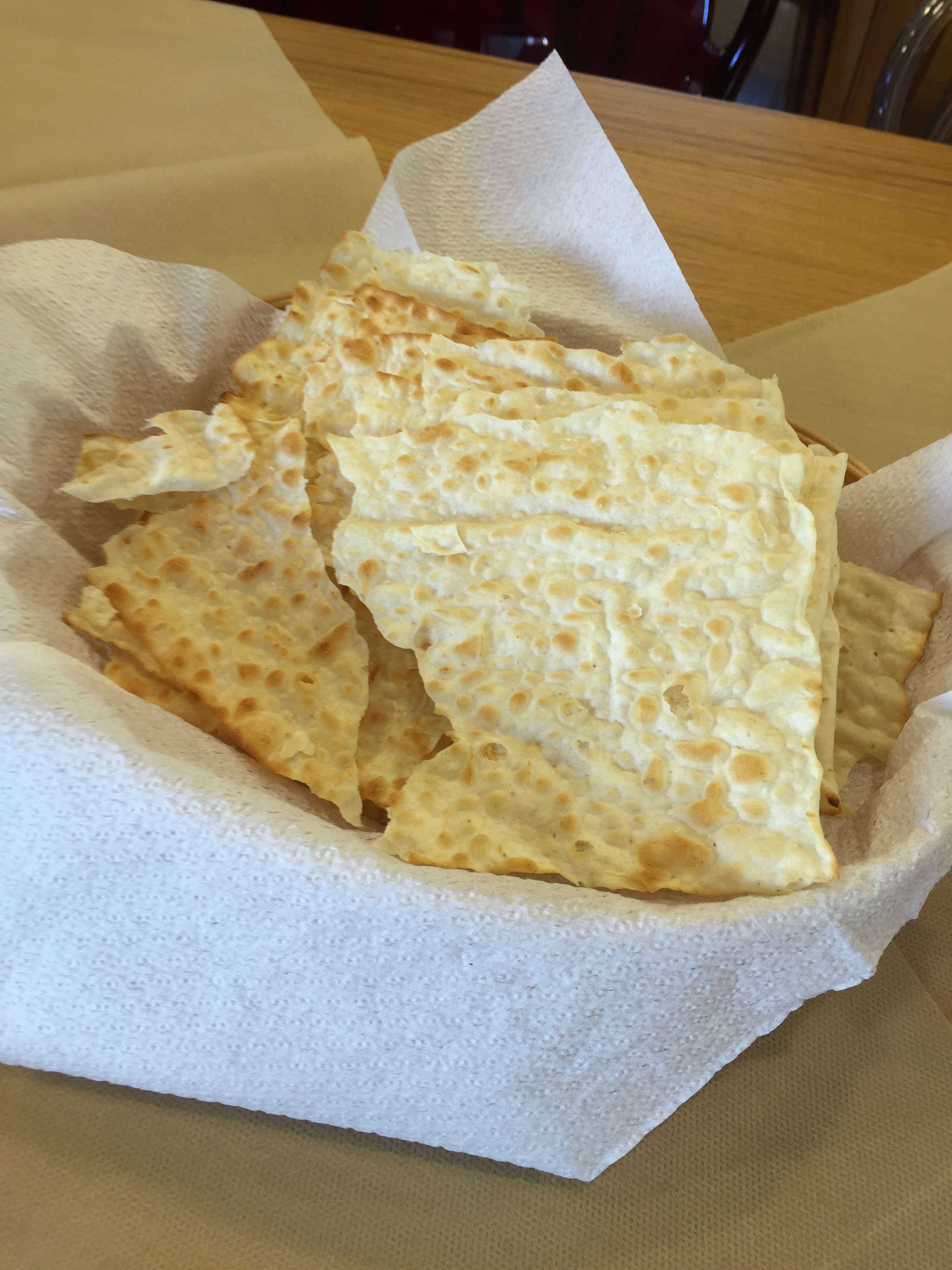 This all has the effect of allowing
the
Sardinians to enjoy a constant supply of local
seafood along with excellent
meats, cheeses and, now, a thriving wine sector
that has adapted to modern
viniculture. Sardinian pecorino, made from sheep’s
milk, is the finest in
Italy, and its suckling pig, porceddu,
is succulent and sweet. Wild boar is available in
season and seasonal seafood
year-round, including the revered bottarga
mullet roe.
Its most famous bread,
called pane
carasau or carta di
musica (music paper) is
exceptionally thin and wafer-like (left), set on
every table when you sit down. The
wines to drink include Cannonau, Vernaccia,
Malvasia and Vermentino, though the
Sardinians drink a lot more local beer than wine.
This all has the effect of allowing
the
Sardinians to enjoy a constant supply of local
seafood along with excellent
meats, cheeses and, now, a thriving wine sector
that has adapted to modern
viniculture. Sardinian pecorino, made from sheep’s
milk, is the finest in
Italy, and its suckling pig, porceddu,
is succulent and sweet. Wild boar is available in
season and seasonal seafood
year-round, including the revered bottarga
mullet roe.
Its most famous bread,
called pane
carasau or carta di
musica (music paper) is
exceptionally thin and wafer-like (left), set on
every table when you sit down. The
wines to drink include Cannonau, Vernaccia,
Malvasia and Vermentino, though the
Sardinians drink a lot more local beer than wine.
As everywhere in Italy, the trattorias are maintaining the old traditions while new ristoranti are refining those same traditions in respectful ways. Three weeks ago I wrote about my visiting the western city of Alghero’s La Boqueria, the trattoria in the fish market where it would be impossible to find fresher seafood, all of it brought in that day, all of it sold by eleven a.m. I feasted on half a dozen platters of it—fried, broiled, grilled, steamed. including glorious langoustines (right). It was my introduction to Sardinian cuisine, and over the next week I learned and loved a great deal about the variety of the food and the gusto of the Sardinians at both traditional and modern restaurants there.
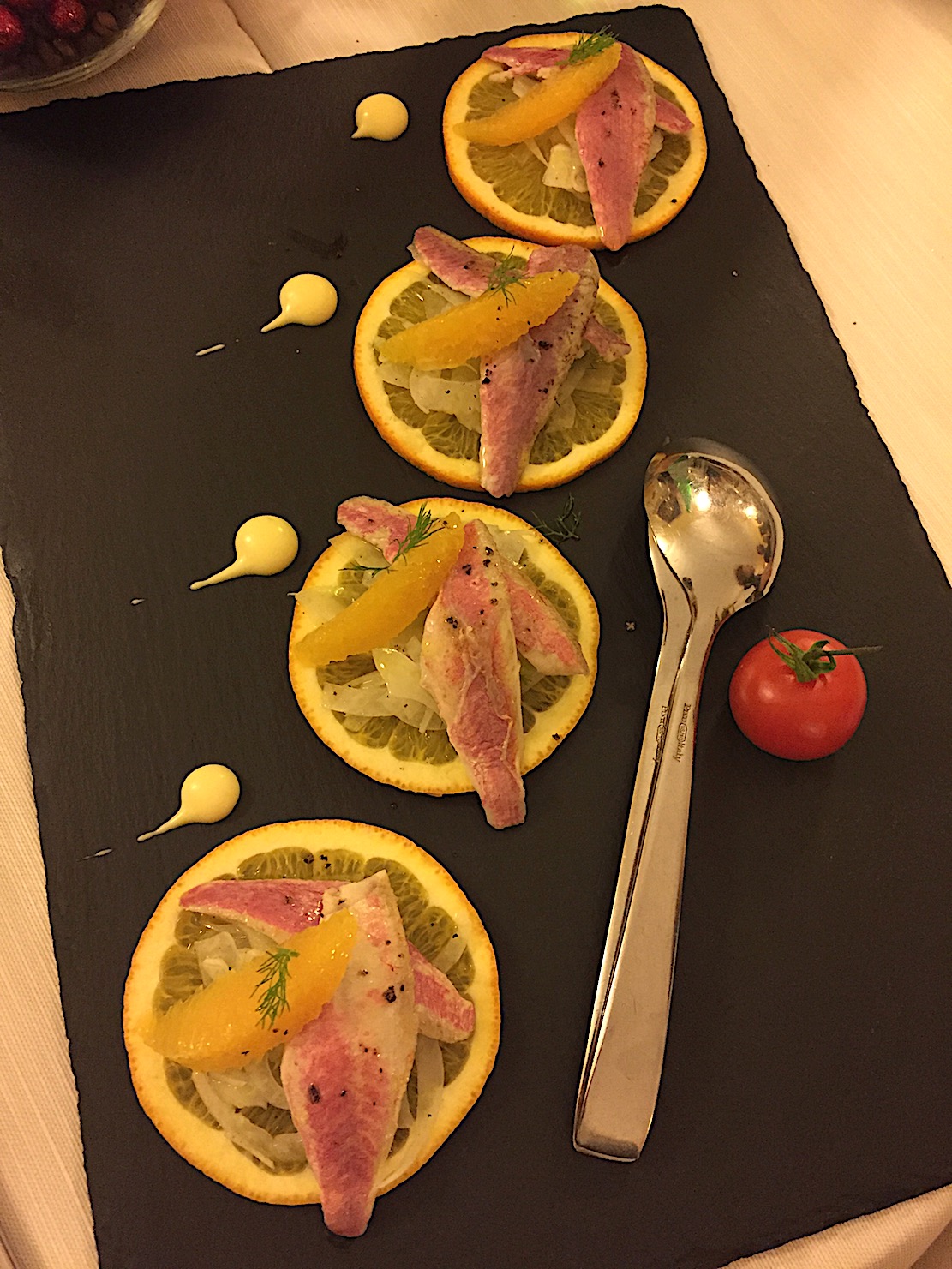 IL
CORALLO
IL
CORALLO
Via Filli Kennedy 20
39 079 982772
Located
on a street named
in honor of the Kennedy Brothers, Il Corallo is a
white-walled barebones
trattoria that nevertheless has draped tables and
abstract artwork on the
walls. Chef Tonino del Rio is the maestro in the
kitchen, and, at a long table
of local winemakers and food writers, I was
astounded at what he sent out—a
panoply of a dozen wonderful dishes, all with
cadenced dispatch,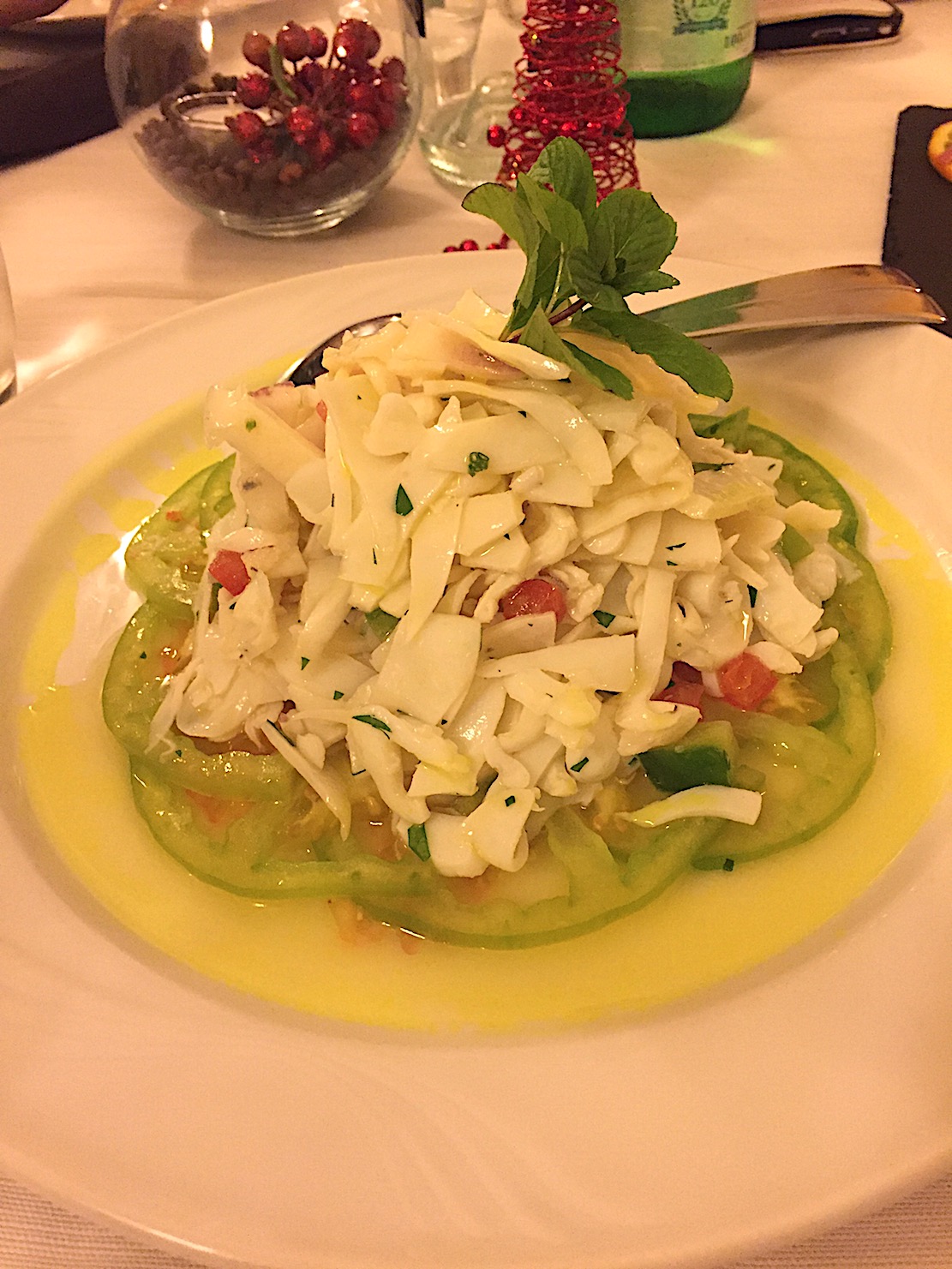 set down
family style.
set down
family style.
We began with a marvelous carpaccio of pesce spada (swordfish) of briny freshness and rose red triglie (mullet) marinated in orange juice (left). Then came seppie (cuttlefish) of mild flavor (they so often can taste fishy if not unstintingly fresh) with ripe tomatoes (right). There was a little salad of sweet peppers and sliced zucchini, then meaty monkfish with artichokes, and tender grilled octopus with a “caviar” made from highly reduced olive oil.
Rasa (ray) was dressed simply with arugula and served with purple potato chips, while fat gambero (shrimp) shared the plate with a puree of porcini mushrooms on toast. Mussels were fried with a light tempura crust and came lashed with a lemony cream sauce, then came a bowl of linguine tossed with buttery sea urchins and morsels of tomato.
Excellent softened pecorino and some warm, soft cookies ended off this splendid dinner, whose diversity would be difficult to find reproduced anywhere outside of the Mediterranean. You may hear that the sea is being over-fished, but you won’t see that in Alghero.
I can’t really give you an idea of what all that would cost per person, but for a three- to four-course meal, without wine, figure on about €40.
Open Wed.-Mon. for lunch and dinner.
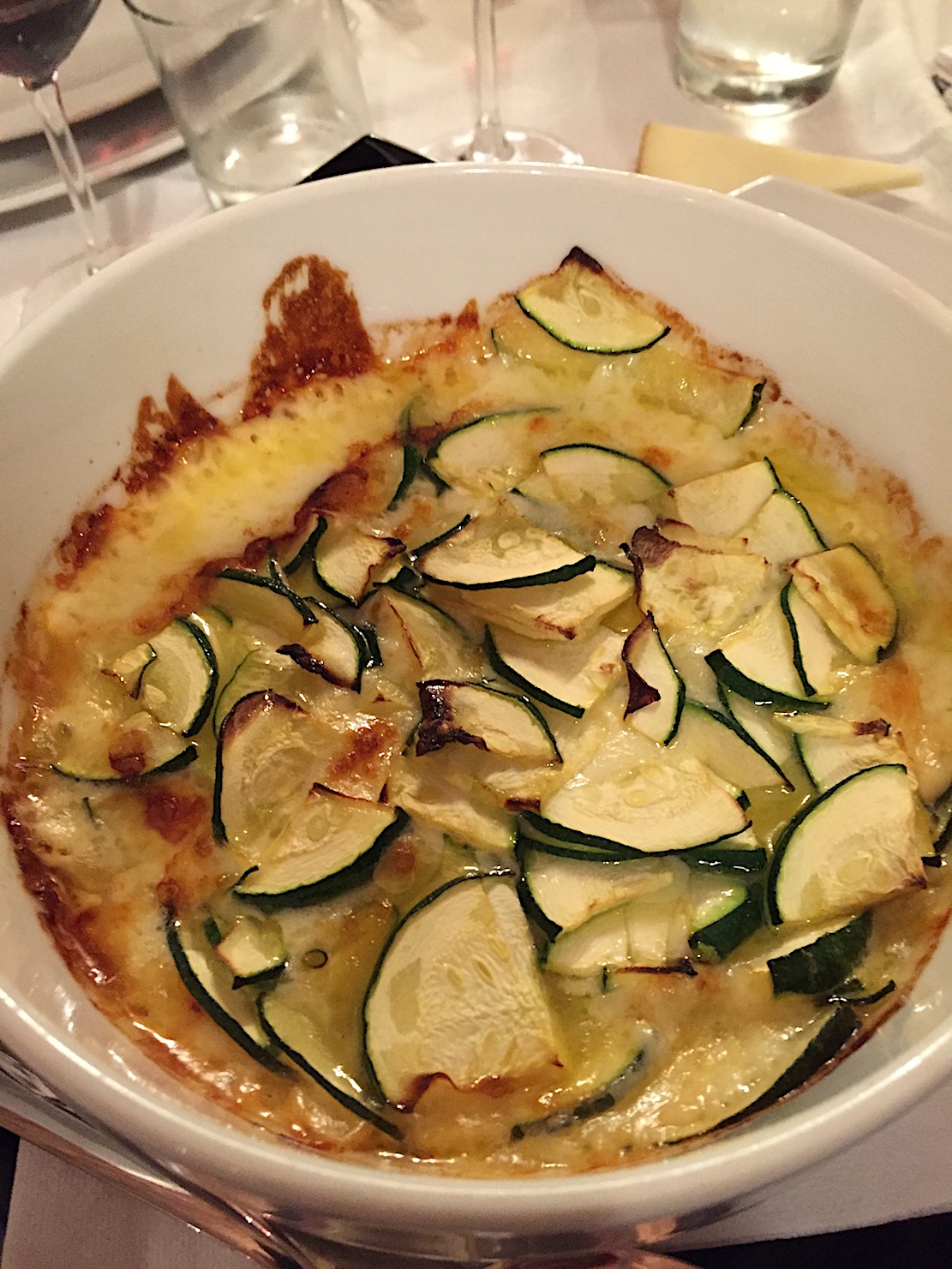 TRATTORIA
MARCO POLO
TRATTORIA
MARCO POLO
Via Cavour 46
39 079 973 8476
Somewhat more creative, but still simply rendered, was the cooking at Trattoria Marco Polo, a new place in the historic center with a beautiful barrel vault brick ceiling, perfect lighting, a blackboard menu and a coziness that makes everyone joyous to be within its two small rooms. If I ever owned a restaurant, this is what I’d want it to look and feel like.
Stefania welcomes everyone at the front and
makes sure your evening will be an enchantment,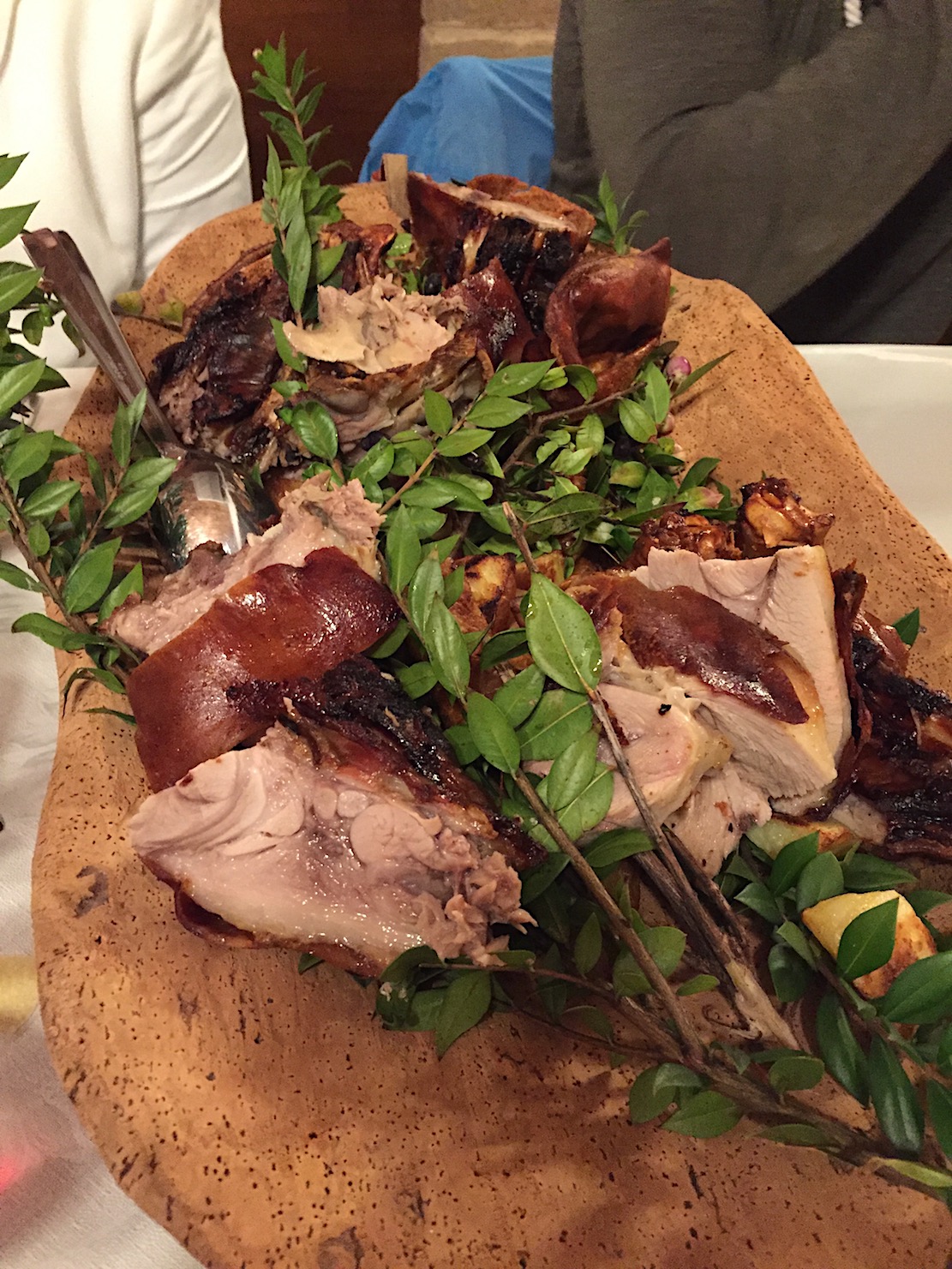 while Gianluca mans the
stoves,
sending out a first course of local charcuterie, a
beef carpaccio with arugula
and tomato, and sweet eggplant alla
parmigiana.
I was swooning
over a browned gratinata
of Sardinian
cheeses and zucchini (left).
while Gianluca mans the
stoves,
sending out a first course of local charcuterie, a
beef carpaccio with arugula
and tomato, and sweet eggplant alla
parmigiana.
I was swooning
over a browned gratinata
of Sardinian
cheeses and zucchini (left).
The pastas that evening were local favorites: culurzones, a large ravioli stuffed with potato, cheese, mint and saffron with a tomato ragù, and wide ribbon pappardelle with olives, batons of fennel and a rich wild boar ragù.
Then came Sardinian porceddu (right), glistening roast suckling pig flavored with myrtle, the meat suffused with its melted fat and the skin crisp as parchment, which went very well with a local Cannonau Riserva 2012.
For dessert there was fried cheese graced with honey; a chocolate torta made with a cream laced with Cannonau wine.
A meal will run you about €35-40, without wine, but tax and service included.
Open for lunch and dinner Tues.-Sun.
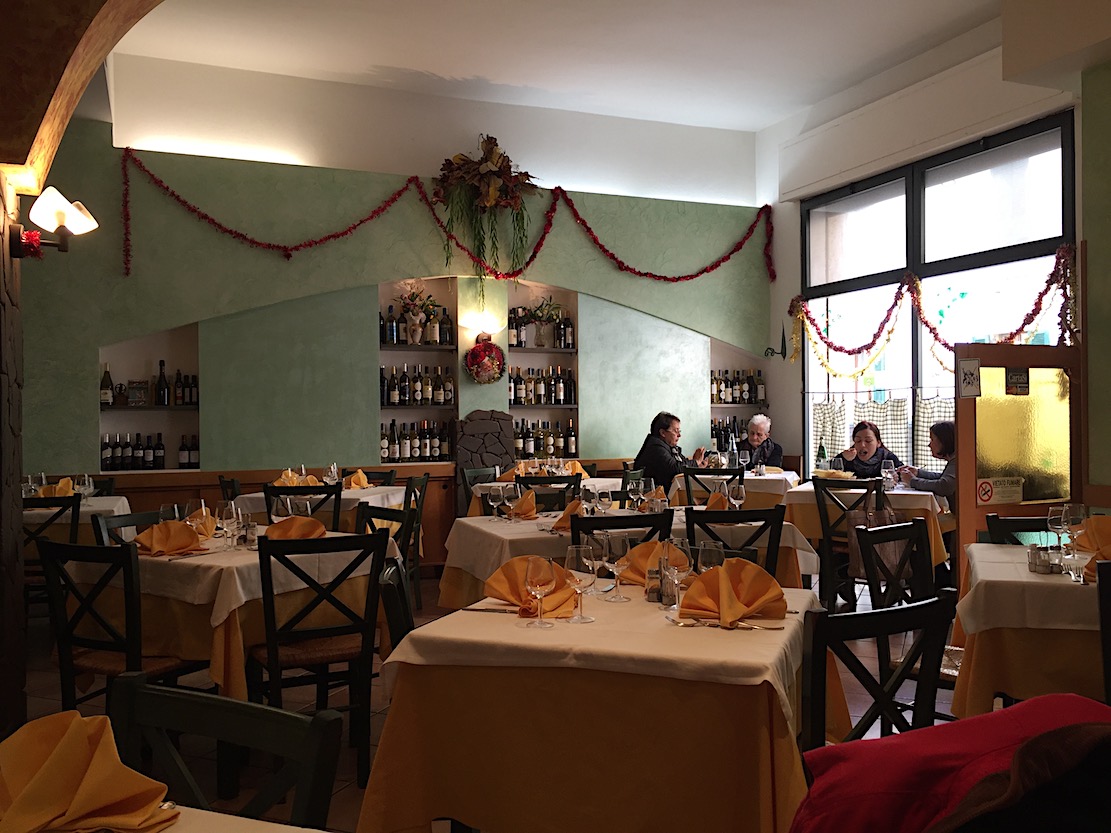 TRATTORIA
MARISTELLA DI SIMONIC E CABONI
TRATTORIA
MARISTELLA DI SIMONIC E CABONI
Via Fratelli Kennedy, 9
+39 079 978 172
A very good lunch or
dinner spot near the arc of Alghero’s stone
barricade on the sea is this
pleasant-looking trattoria favored by the locals,
with a simple menu of Italian
and Sardinian classics 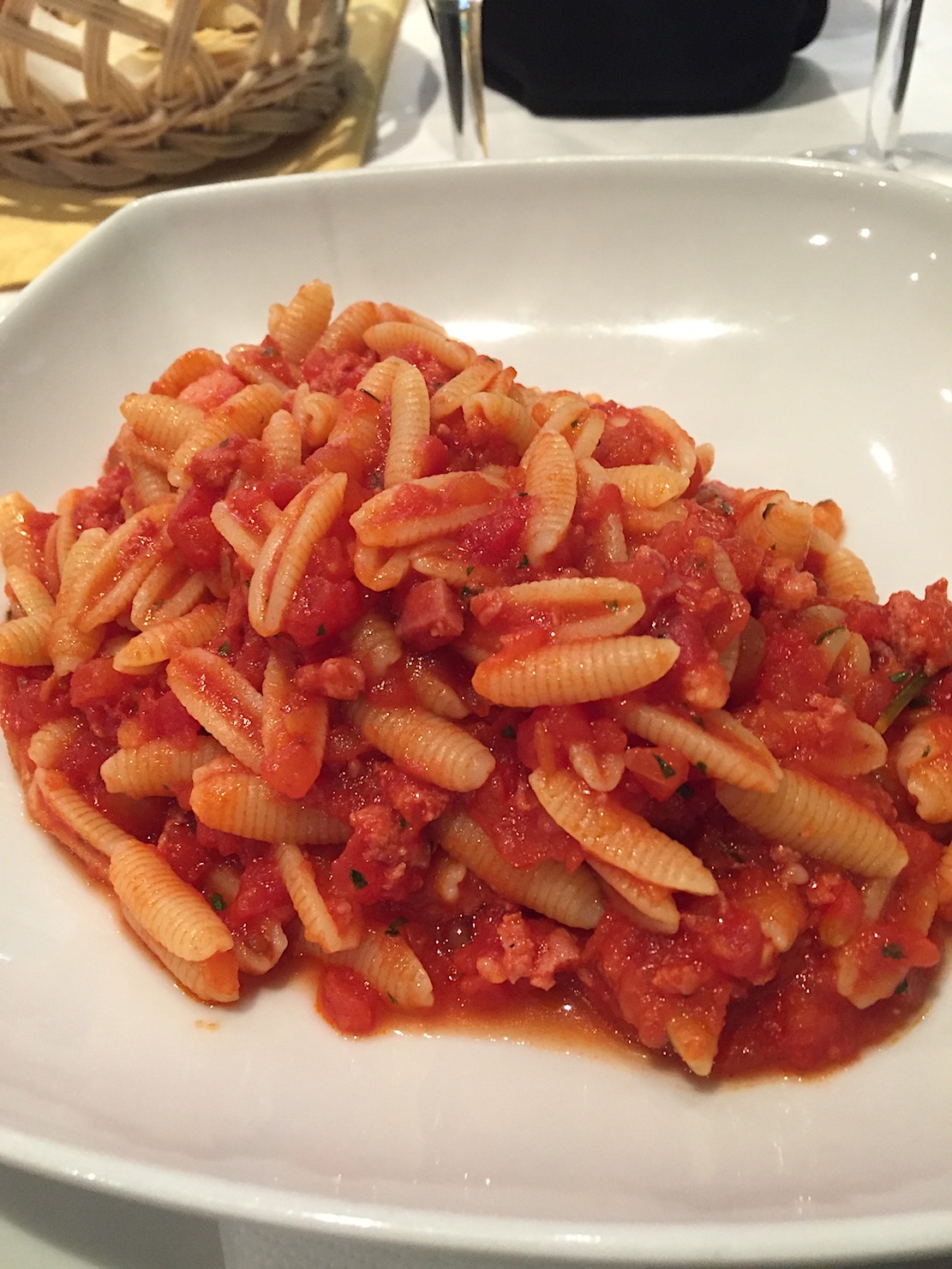 as
dependable as sunrise and sunset.
as
dependable as sunrise and sunset.
The walls are sea green, the linens white and corn yellow, and the windows are hung with wreaths of dried red peppers. The chairs are admirably sturdy and there is a wall of wines to peruse after ordering from the menu.
A friend and I nibbled on the bread and carasau wafers, which went well with the various crudi served on the half shell as a selection of six species brought in that morning. The crisp, golden fried calamari made for a good nibble as an antipasto.
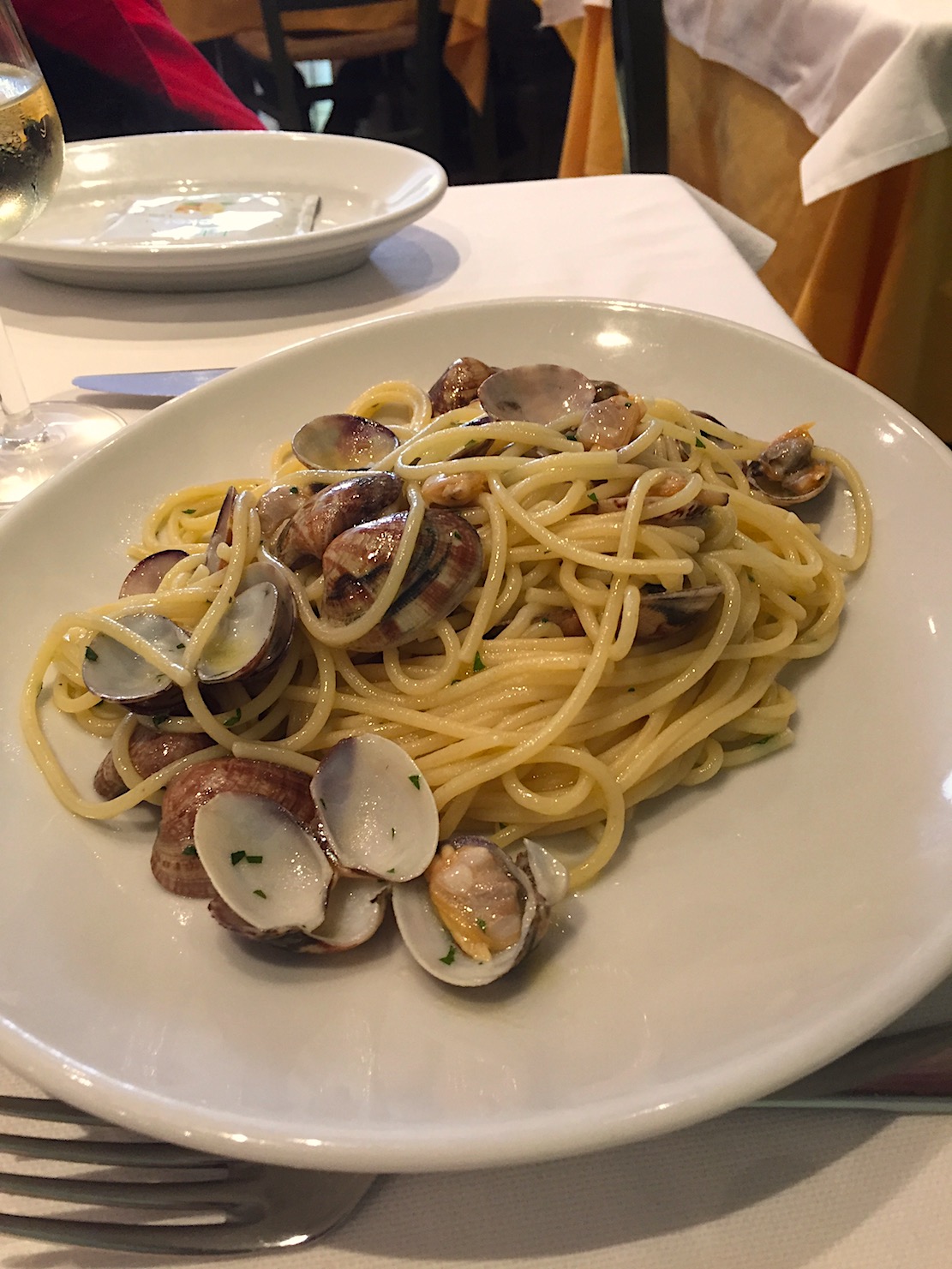 Our appetites sparked,
we
then dug into one of the best renderings of
spaghetti with clams and garlic
I’ve ever had. (Spaghetti, by the way, is a far
better pasta to use for this
dish than the usual linguine.) Perfectly al dente,
the pasta was coated with
the olive oil and clam liquid, the clams—left in
their shells, of course!—were
sweet and sea-flavored. You may
also have this dish with olives and toasted
breadcrumbs (left).
Our appetites sparked,
we
then dug into one of the best renderings of
spaghetti with clams and garlic
I’ve ever had. (Spaghetti, by the way, is a far
better pasta to use for this
dish than the usual linguine.) Perfectly al dente,
the pasta was coated with
the olive oil and clam liquid, the clams—left in
their shells, of course!—were
sweet and sea-flavored. You may
also have this dish with olives and toasted
breadcrumbs (left).
Another pasta we tried was malloreddus (above), which are like ribbed cavatelli, with just enough spicy tomato sauce to coat each one. The grilled fish is just given a blessing of olive oil and lemon: that day pagro (sea bream, known as porgy in America), was a special, grilled to have a faint smokiness. You might also consider a mixed grill of fish, octopus and Mediterranean lobster. Or a mussel-based couscous.
You’ll probably want to skip desserts here.
A meal will run you about €35-40, without wine, but tax and service included.
Open for lunch and dinner
daily.
❖❖❖
By John Mariani
212-682-5678
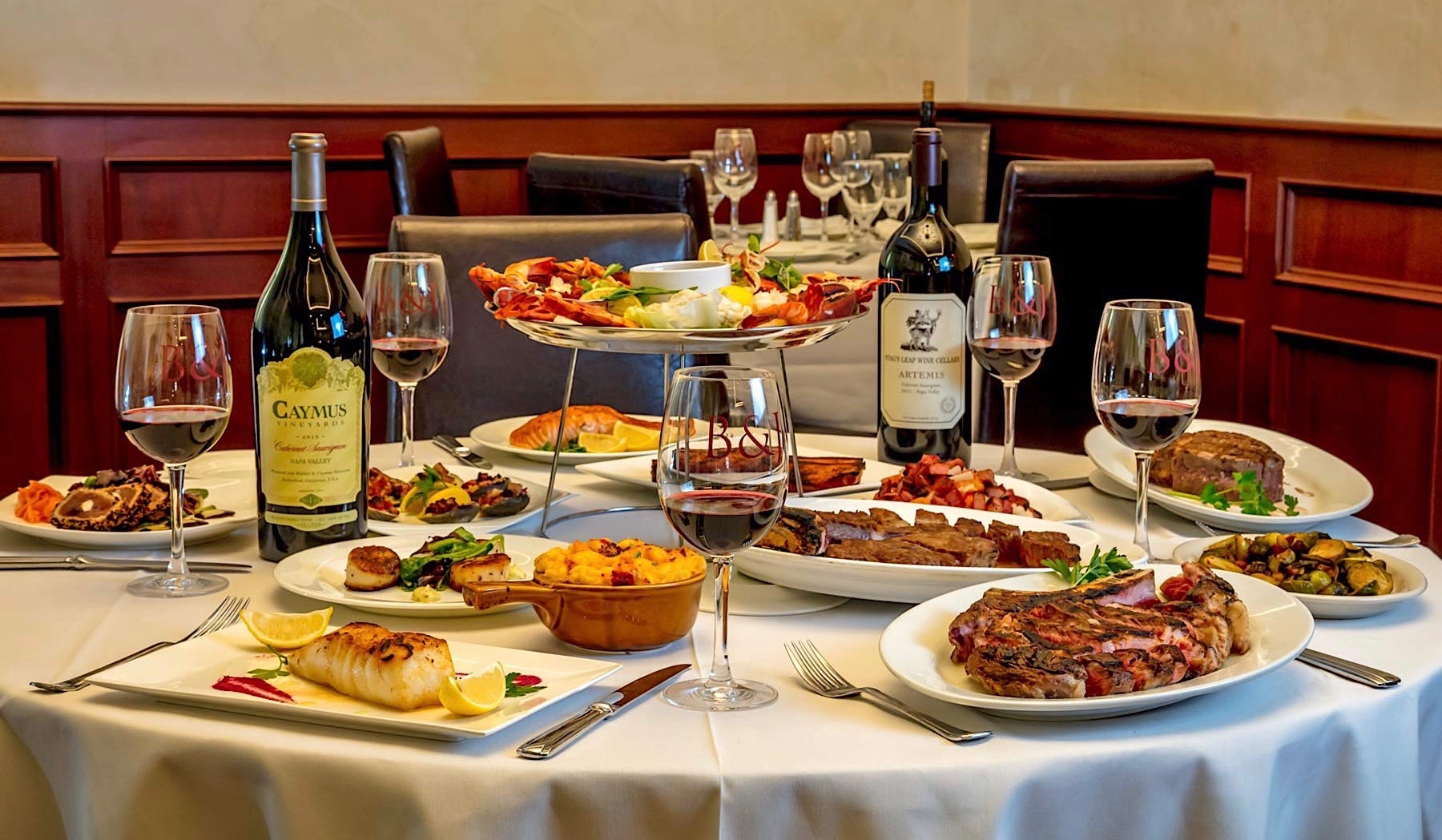
I could throw a stone off the terrace of Grand Central Terminal and hit at least ten first-rate steakhouses, all with more or less the same menu, all striving to serve first-rate USDA Prime beef. The distinctions, however, are not just in the decors but in the greeting and caretaking of guests. At places like Palm and Smith & Wollensky, do not expect much more than a grunt of acknowledgment if you’re not a regular. At national chains like Capitol Grille and Del Frisco’s it will be formally correct in a corporate way. And at a few, like Ben & Jack’s, the greeting will most likely be warm and even effusive. Owners Ben and Jack Sinanaj, with two siblings, Harry and Russ, really, really want you to come back as often as possible, and they work hard at making you a regular.
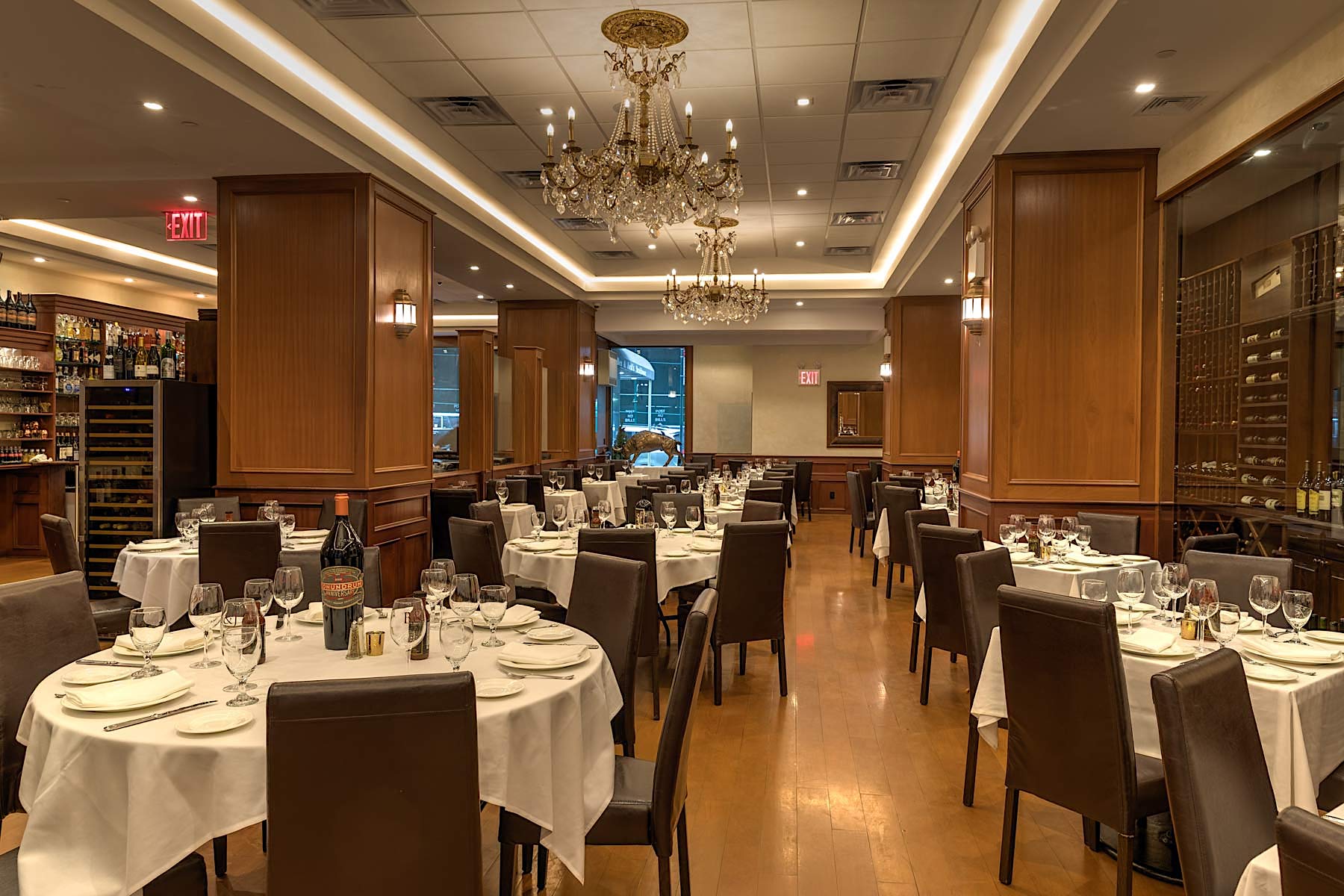 The original B&J’s
opened on these East 44th Street premises ten
years ago and was recently
re-opened—the building had been gutted and a hotel
put in—and though it’s a
brand new décor, it still abides by the
old-fashioned look of dark wood, pale
walls, and big, well-set tables. Chandeliers add a
touch of elegance, but the
lighting itself needs a lift: it is low and flat
and should look more like it does in
the appealing accompanying photograph. The
crowd—O
tempores! O mores!—dresses
down for the most part. It's now very casual.
The original B&J’s
opened on these East 44th Street premises ten
years ago and was recently
re-opened—the building had been gutted and a hotel
put in—and though it’s a
brand new décor, it still abides by the
old-fashioned look of dark wood, pale
walls, and big, well-set tables. Chandeliers add a
touch of elegance, but the
lighting itself needs a lift: it is low and flat
and should look more like it does in
the appealing accompanying photograph. The
crowd—O
tempores! O mores!—dresses
down for the most part. It's now very casual.
You’ll get a big basket of good breads to start with while you peruse the wine list, which hasn’t improved much in the past few years, with too many overly familiar labels, not in a league with their nearby competitors’ lists. The bar does make excellent, well-proportioned cocktails.
The menu does not stray from the New York steakhouse template, and specials are few on a nightly basis. The raw bar always has platters of both East Coast ($17) and West Coast oysters ($24) available, along with the usual shrimp and crabmeat cocktails (both $23).
Yellowfin
tuna tartare with avocado and seaweed salad ($21)
could have used more spark in the seasoning, while
perfectly 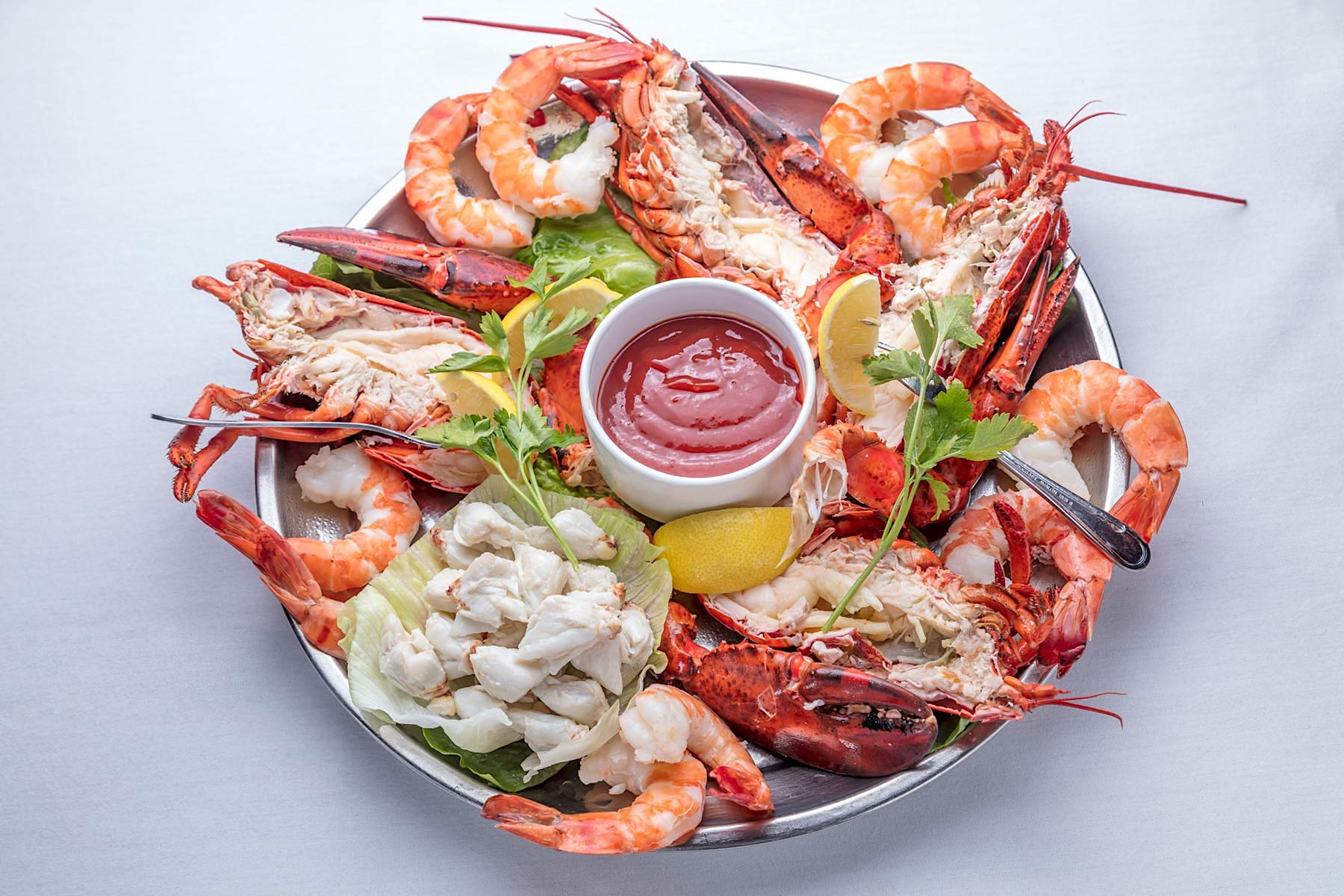 good sea
scallops
($21) came seared but steamy one evening. A
lobster bisque had an admirable
component of lobster morsels but the bisque itself
was one-dimensional
($14). I’m
a sucker for an
old-fashioned Iceberg lettuce wedge when its
appealing crisp texture is added
to with a rich Roquefort cheese dressing,
amazingly good tomatoes for June and
nice chunks of bacon ($16), as it is at
J&B's..
good sea
scallops
($21) came seared but steamy one evening. A
lobster bisque had an admirable
component of lobster morsels but the bisque itself
was one-dimensional
($14). I’m
a sucker for an
old-fashioned Iceberg lettuce wedge when its
appealing crisp texture is added
to with a rich Roquefort cheese dressing,
amazingly good tomatoes for June and
nice chunks of bacon ($16), as it is at
J&B's..
Last time I reported on Ben & Jack’s a few years ago, I was critical of crabcakes that were very little crab and too much breading. The ones I had as an entrée last week were a 180-degree different turn for the better—just enough breading to bind big sweet jumbo lump pieces of crab (two for $42; one for $22).
With its steaks B&J is buying very good beef with a light mineral flavor and good char on the outside. The options range from porterhouse cuts for two ($104), three ($156) or four ($208), along with filet mignon ($51) and others. Frankly, even four of us took some of the very generous steak for two home. An order of veal chop brought two hefty ones on a plate ($52).
 The service of
the steaks
follows the tradition set at Peter Luger’s decades
ago of bringing the beef out
on red-hot plates set at an angle on a another
plate on the table. It’s only a
small bit of showmanship, but to tell the truth, a
perfectly cooked steak is
going to go on cooking on such a hot surface. Ask your waiter for your
steak to be served on a warm, not
scorchingly hot, plate.
The service of
the steaks
follows the tradition set at Peter Luger’s decades
ago of bringing the beef out
on red-hot plates set at an angle on a another
plate on the table. It’s only a
small bit of showmanship, but to tell the truth, a
perfectly cooked steak is
going to go on cooking on such a hot surface. Ask your waiter for your
steak to be served on a warm, not
scorchingly hot, plate.
The buttermilk onions rings (11) are as good as ever, and the French fries ($11) are just about perfect—no need for dried truffles or sprinklings of herbs. A side order of broccoli ($11) was, however, overcooked, perhaps too long in advance.
B&J’s brings in New York’s vaunted S&S Cheesecake (left)—always worth ordering—as well as a creditable crème brûlée and a pecan pie made on the premises.
As I said, attentive, cordial service is a distinguishing mark at B&J’s, whether or not you’re a regular. If they turn up the lights a little, it’ll be even more of a convivial option in the area.
Open daily for lunch and dinner.
❖❖❖
FOR FATHER'S DAY
By John Mariani
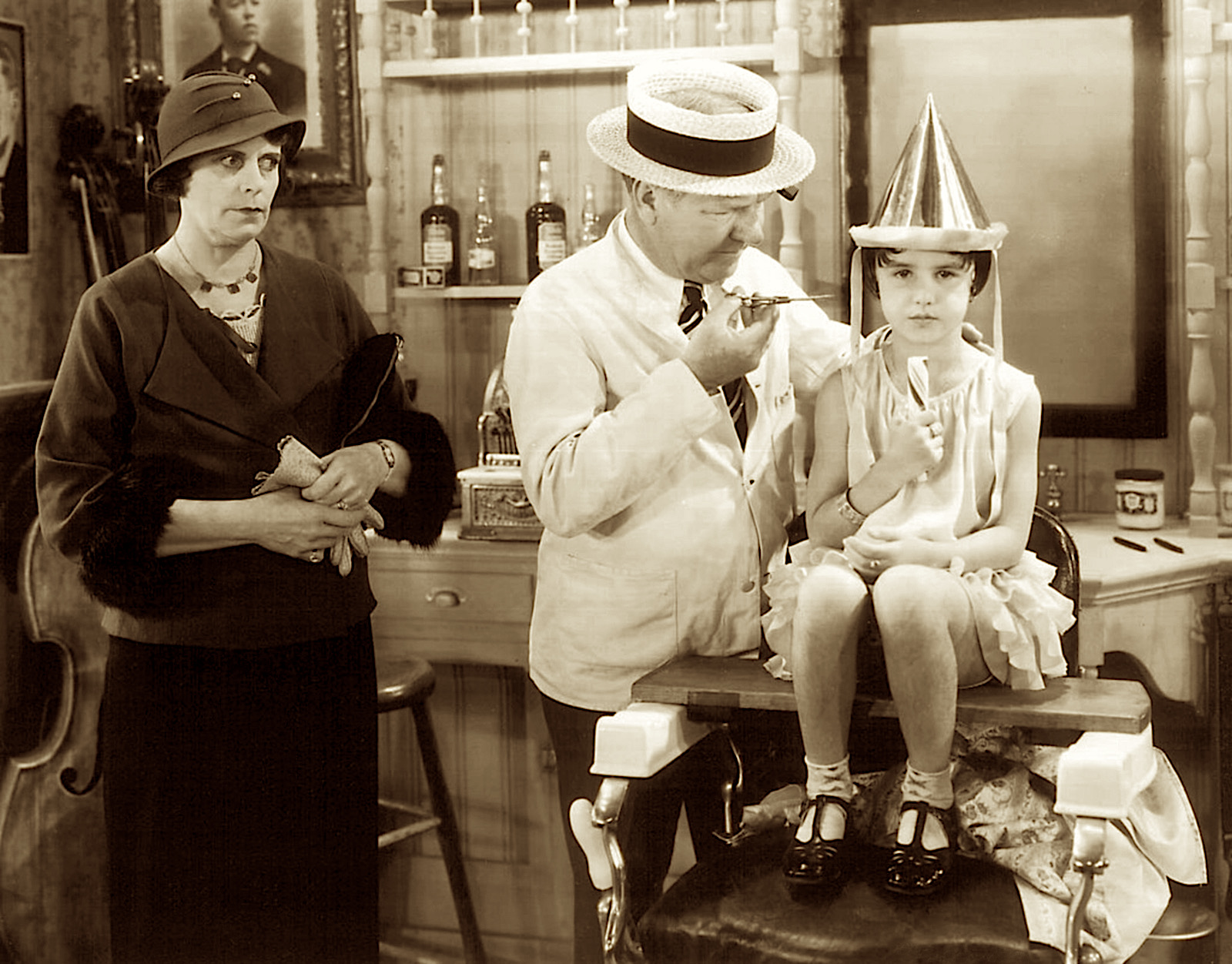
For Mother’s Day mothers get flowers and scarves and crayon drawings. Fathers inevitably get Duluth underwear or Lands’ End Comfort Waist shorts. If they’re lucky they get booze, and most dads are happy with whatever their favorite Scotch has been for decades, like Dewar’s or Chivas. Those who wish to go outside that comfort zone might consider these spirits—or some very good wines—to give the old man. Here are some I intend to enjoy.
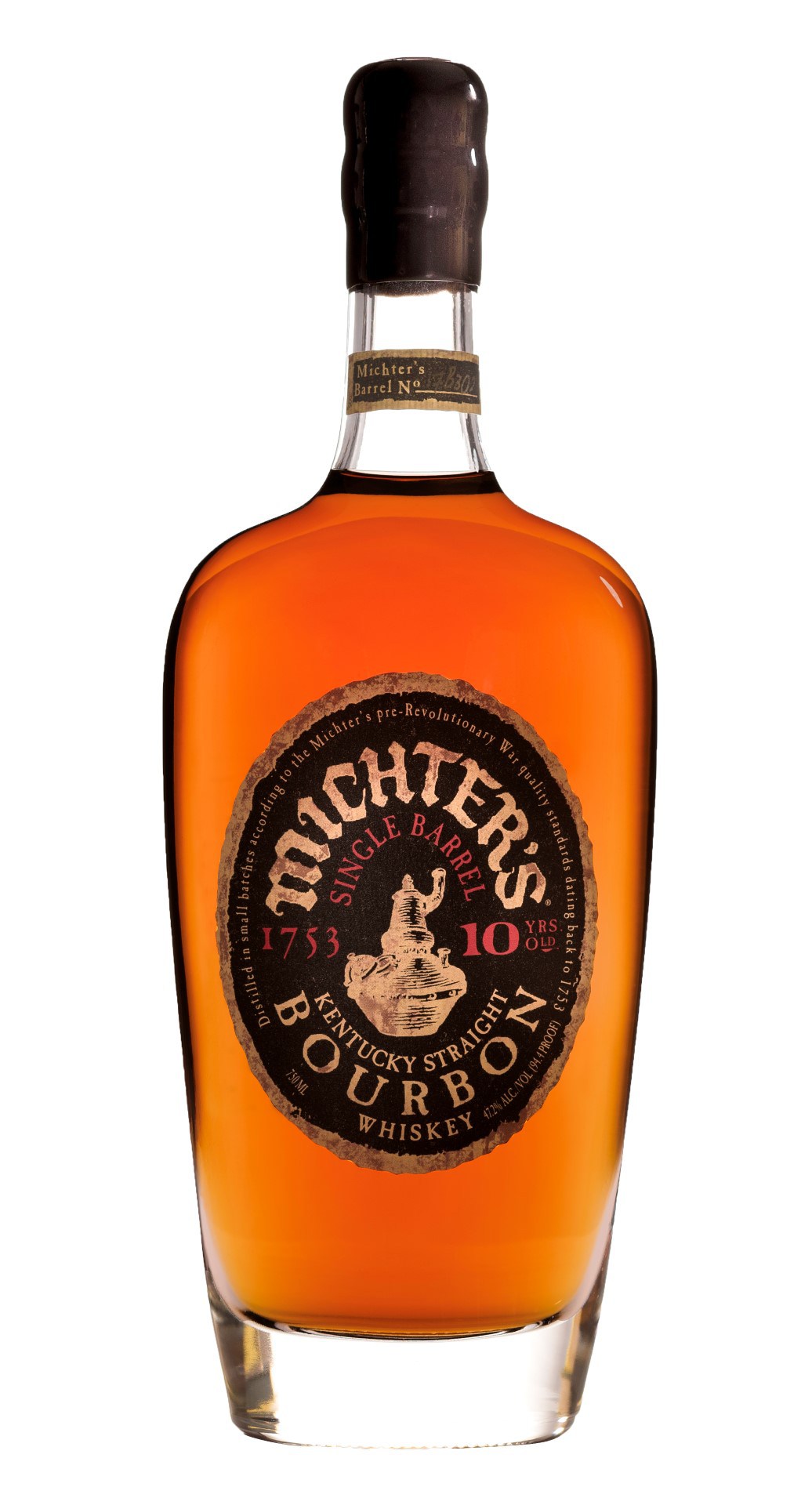 MICHTER’S
SINGLE BARREL 10 YRS. OLD KENTUCKY STRAIGHT
BOURBON ($175-$200)—Michter’s has
been growing its reputation on the
basis of new releases of bourbon and rye. Some,
like this single barrel
offering, are sold as collector’s items with only
24 barrels produced. Master Distiller Willie Pratt ages this one
for ten years—considerably
longer than most bourbons—and its price reflects
not just its rarity but its
refinement. A bourbon-loving dad will probably
just ogle the bottle for hours
before opening it to share with with close
relatives and friends.
MICHTER’S
SINGLE BARREL 10 YRS. OLD KENTUCKY STRAIGHT
BOURBON ($175-$200)—Michter’s has
been growing its reputation on the
basis of new releases of bourbon and rye. Some,
like this single barrel
offering, are sold as collector’s items with only
24 barrels produced. Master Distiller Willie Pratt ages this one
for ten years—considerably
longer than most bourbons—and its price reflects
not just its rarity but its
refinement. A bourbon-loving dad will probably
just ogle the bottle for hours
before opening it to share with with close
relatives and friends.
KOPKE COLHEITA 1999 PORTO ($50)—Don’t get me started on how Port producers continue to shoot themselves in the foot by offering so many kinds and grades of their products—white, ruby, tawny, colheita, vintage, crusted, late bottled, and on and on. Suffice it to say this delicious colheita (a single vintage dated tawny) has a real vibrancy and, if shy of a true vintage Port you’d have to wait another decade to mature, this nine-year-old has come around beautifully. I’ve enjoyed it immensely recently with very ripe pears and Gorgonzola cheese.
RON
BARCELÓ IMPERIAL ONYX DOMINICAN RUM
($40)—Just released this spring, this
Dominican rum from a firm founded by Julian
Barceló in 1930 is a dark añejo
blended from 10-year-old rums made not with
molasses but from their own farmed
sugar cane. It is aged in ex-bourbon barrels that
are, uncharacteristically,
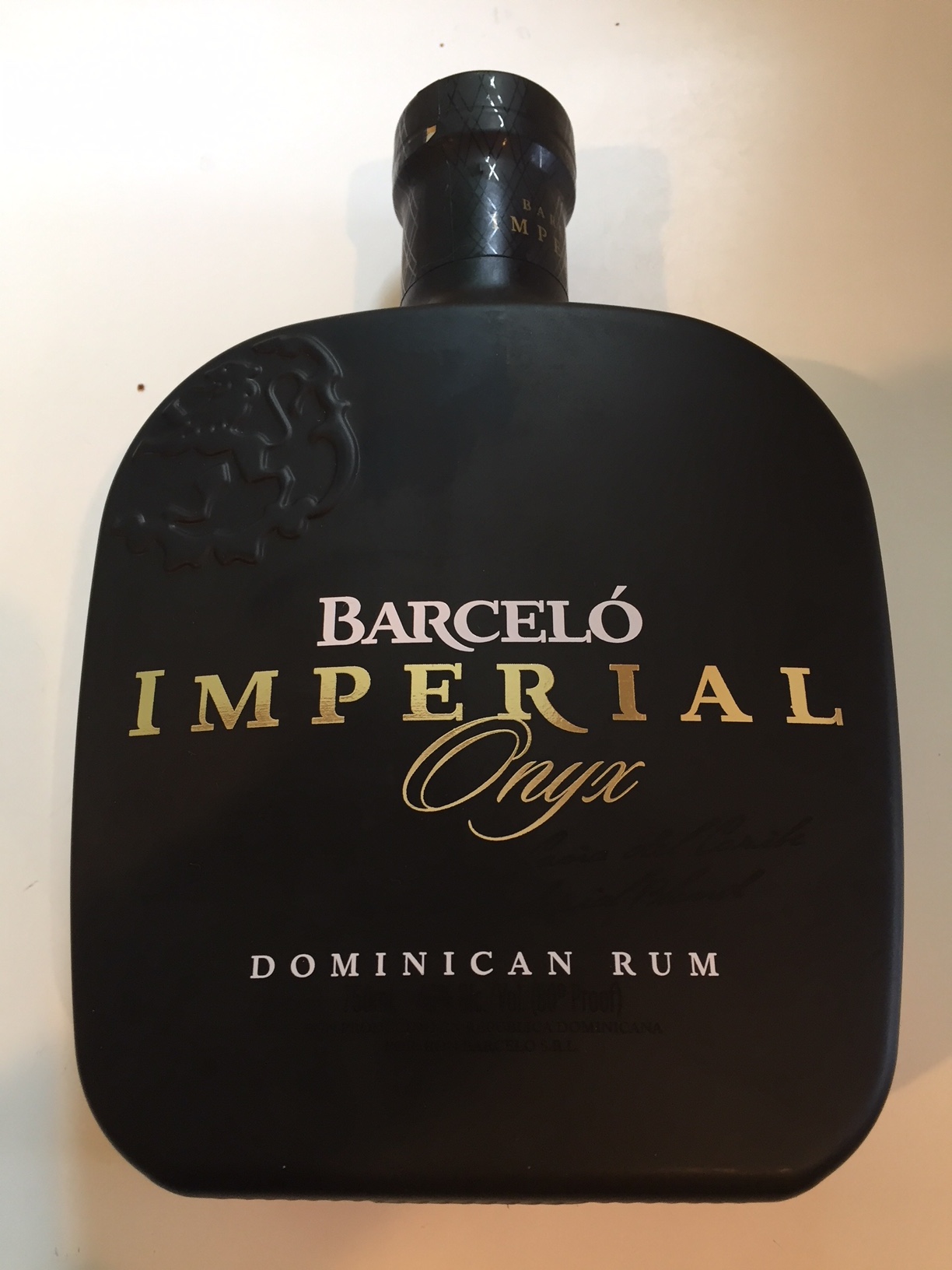 heavily charred, then filtered
through onyx stones, which sounds gimmicky.
Whatever, it is a very rich, very distinctive rum
with the oak balanced out by
dark fruit flavors. Not intended to be mixed with
lemons or limes but to be
sipped after dinner wearing a white straw hat.
heavily charred, then filtered
through onyx stones, which sounds gimmicky.
Whatever, it is a very rich, very distinctive rum
with the oak balanced out by
dark fruit flavors. Not intended to be mixed with
lemons or limes but to be
sipped after dinner wearing a white straw hat.
SAN PEDRO 1865 SINGLE VINEYARD CHARDONNAY 2015 ($15-$17)—Chile now makes and exports a tremendous amount of wine, and, while quality is rising, too much bulk wine still gets shipped out. Viña San Pedro dates back 153 years and is now part of the VSPT Wine Group, the third largest vitivinicultural group in Chile and the second largest exporter of Chilean wine. But this Chardonnay, produced in cool climate Molina by a young enologist named Matías Cruzat, is part of Viña San Pedro’s fine 1865 portfolio. Well priced, this three-year old with 14% alcohol has enough age on it to reveal its layers of settled flavors, fruits and acids. Excellent all summer long with seafood of every kind.

MUI-GRIES
LAGRIEIN 2016 ($18)—Located on the
site of a former Benedictine monastery in Italy’s
Sud-Tirol-Alto Adige region,
many vines date back to the 1930s.
The indigenous Lagrein grape, allied
genetically with Teroldego, Pinot
Noir and Syrah, is far from a well-known varietal
(it has a DOC), but good
examples like Mui-Gries are spreading its
popularity. Very few are available in
the U.S. market, so a connoisseur
dad will be happy you brought a bottle like this
to his attention. With 13.5%
alcohol it has medium body and goes well with
simple meat dishes and risottos.
CRAGGY
RANGE TE KAHU SINGLE VINEYARD 2015 ($20)—Twenty-five years ago Terry Peabody and
his wife, Mary, bought up
untouched land in the Gimblett Gravels
Winegrowing district in Hawke’s Bay,
intent on making a variety of wines but focusing
on Bordeaux-style blends not
then in fashion in New Zealand. One result has
been Te Kahu—“the cloak,”
referring to the shroud of mist that covers the
vineyards in the evenings. At
just 14% alcohol, it is a robust but restrained
blend of 76% Merlot, 14%
Cabernet Sauvignon, 8% Carbernet Franc and 2%
Malbec, making for a very
satisfying ready-to-drink red with already
softened tannins.
❖❖❖

"Cheetos
may be the saltiest food known to mankind, so it makes
sense that the only wine that stands a chance against
these cheesy salt blasts would be as acidic as possible.
White wine from Sancerre — an appellation in central
France is made from Sauvignon Blanc. While it may seem
odd to pair wine produced a few hours south of Paris
with a bright-orange cheese snack invented in Dallas,
the rip-roaring acidity of white Sancerre has a natural
symbiosis with the corn, cheese, and salt of Cheetos. White Sancerre also tends to be super textured,
which means that when you swish it around as you drink
it, it will coat all of the fleshy parts and give the
inside of your mouth a fighting chance against all that
Cheetos buildup. Think of the
subtle briny salinity of an oyster as an example.
Sancerre’s own minerality will keep the intensity of the
Cheetos in check.”--Vanessa Price, "How
to Pair Wine With Cheetos,"
Wine
Column Sponsored by Banfi Vintners
SANGIOVESE
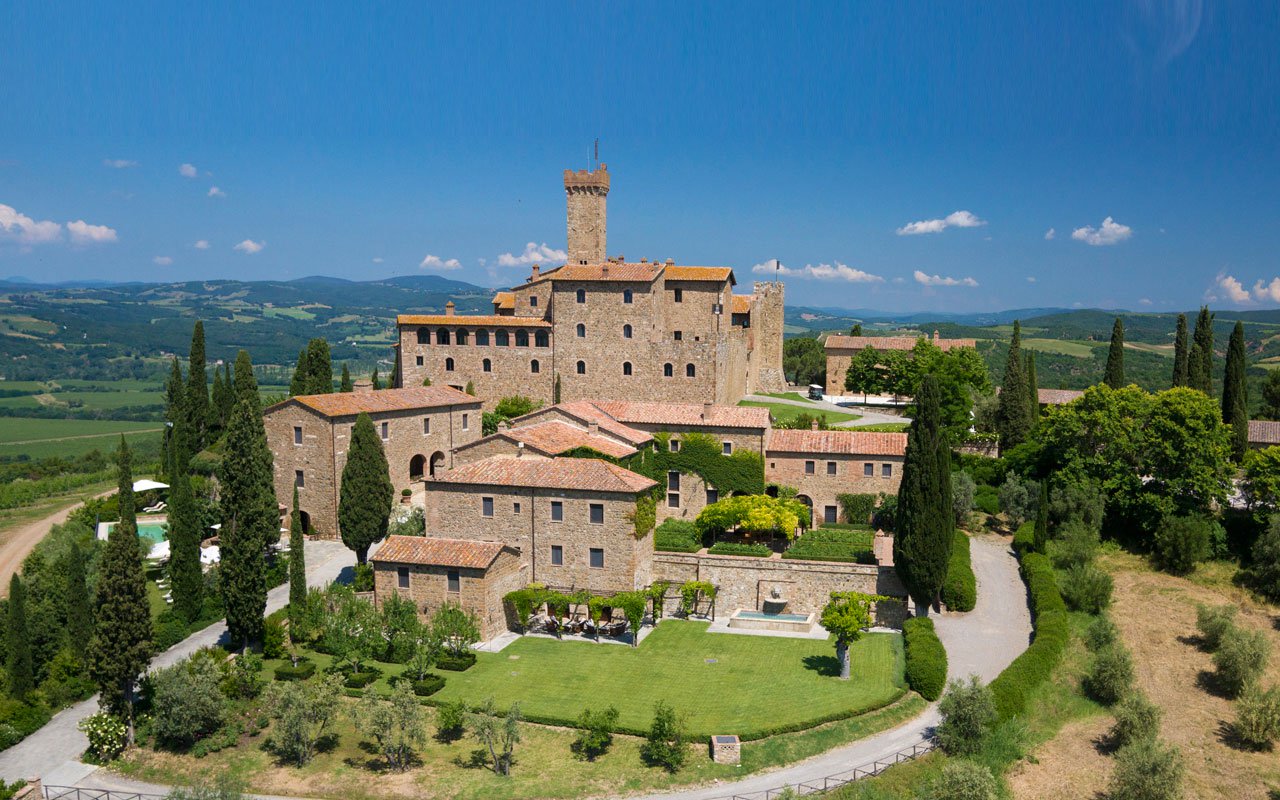 Wine is a joy year-round but
in cooler weather one
grape varietal has really taken center stage in
my daily activities – that most Italian of
grapes, Sangiovese, and its ultimate expression
– Brunello di Montalcino.
Wine is a joy year-round but
in cooler weather one
grape varietal has really taken center stage in
my daily activities – that most Italian of
grapes, Sangiovese, and its ultimate expression
– Brunello di Montalcino.
From mid-September through mid-October,
the Sangiovese grown for our various styles of red
wines are be harvested, culminating with the top
selection for Brunello di Montalcino.
Second, cooler weather here means
it is time to start enjoying more red wines and
especially Sangiovese based wines. That
includes Banfi’s cru of Brunello, Poggio alle Mura,
literally the cream of the crop of our Sangiovese
vineyards. Alongside our Poggio alle Mura Brunello di
Montalcino, this year we introduced two more wines
from the cru Poggio alle Mura – a Rosso di Montalcino
and a Riserva of Brunello. Rosso is sort of like the
younger brother of Brunello, also made from 100%
Sangiovese grapes but usually a selection from younger
vines and the wine is aged only two years compared to
the four required for Brunello. The
Riserva, on the other hand, is an even more selective
harvest of Sangiovese, and ages for an additional year
before release.
What is so special about this cru
Poggio alle Mura?
Well, it is the result our over 30 years of
ongoing research at my family’s vineyard estate,
Castello Banfi.
When we first began planting our vines there in
the late 1970s studies from the University of Bordeaux
indicated which strains of many varietals we should
plant, based on the soil type and microclimate of each
vineyard. But
when it came to the region’s native Sangiovese, there
was only local lore, no scientific research. So we took
it upon ourselves to figure out this vine, and set off
on three decades of incredibly detailed research.
We started
with 600 apparent variations on Sangiovese, because it
is so susceptible to variations in weather and soil,
and narrowed that down to 160 truly genetically
different clones.
We planted a vineyard with two rows of each
type, made wine from each of them, and charted the
differences – remember, you only get one chance a year
to make wine, so this took time.
It took about ten years to get some
concrete results, though we continue to experiment
today and always will – you never stop learning in
science and nature!
Once we determined which were the best,
complementary clones that could be planted together to
make the best Brunello, we chose to plant them in what
we determined to be the optimal vineyard sites. Coincidentally,
the best soils and climate conditions are in the
slopes surrounding the medieval fortress today known
as Castello Banfi, known since Etruscan times as
Poggio alle Mura – the walled hilltop. Hence the
name of our most special “cru” of Brunello,
representing a synthesis between tradition and
innovation.
Though the focus of this study was
our Brunello, all of our Sangiovese-based wines,
including the super Tuscans SummuS, Cum Laude, and
Centine, benefitted from this work. And that’s
the third reason for celebrating Sangiovese this
month, for the range of wonderful reds that usher us
into autumn! One
wine in particular was inspired by our research – the
BelnerO, a Sangiovese dominant blend with what I like
to call a kiss of Cabernet and a whisper of Merlot. We grow the
grapes a little differently for BelnerO than for
Brunello, make the wine with less oak aging and
released it earlier from the winery, providing a
counterpoint to Brunello and a lovely terroir-driven
wine in its own right.
If you
know Italians, you know that by nature we are
multi-faceted, varying in mood, and always passionate. As a
nation, we span from the hot sunny beaches of Sicily
near the African coast to the rugged mountains and
Alpine ski slopes of Trentino-Alto Adige in the north. Sangiovese
is grown in almost all of Italy’s regions and reflects
the unique nature of each; it is most famous
(rightfully so) in Tuscany, yet even there it reflects
the nuances of each hilltop, valley and subzone. It has
something a little different to say in Brunello than
Chianti, Morellino than Vino Nobile di Montepulciano,
Rosso di Montalcino than Super Tuscan blends.
Here is a smattering of
Sangiovese-based wines that you may wish to get to
know better, reflecting a spectrum that appeals to
every occasion, every taste, and every budget. We can
assure you that the conversation will never become
boring. 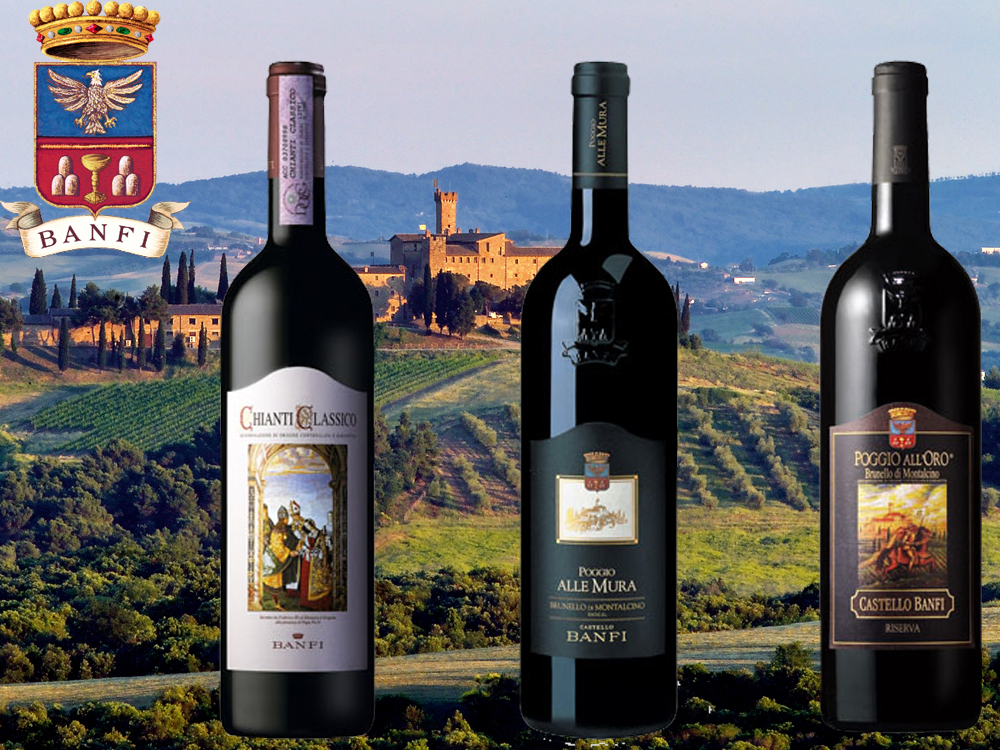
Recommendations for Celebrating
Sangiovese
BelnerO Proprietor’s Reserve Sangiovese
– A refined
cuvée of noble red grapes perfected by our pioneering
clonal research. This dark beauty, BelnerO, is
produced at our innovative winery, chosen 11
consecutive years as Italy’s Premier Vineyard Estate.
Fermented in our patented temperature controlled
French oak and aged approximately 2 additional years.
Unfiltered, and Nitrogen bottled to minimize sulfites.
Castello Banfi Brunello di Montalcino –
Rich, round, velvety and intensely
aromatic, with flavor hints of licorice, cherry, and
spices. Brunello di Montalcino possesses an intense
ruby-red color, and a depth, complexity and opulence
that is softened by an elegant, lingering aftertaste.
Unfiltered after 1998 vintage.
Castello Banfi Rosso di Montalcino – Brunello's "younger brother," produced
from select Sangiovese grapes and aged in barrique for
10 to 12 months. Deep ruby-red, elegant, vibrant,
well-balanced and stylish with a dry velvety
finish.
Poggio all’Oro Brunello di Montalcino
Riserva – A single vineyard selection of our most
historically outstanding Sangiovese, aged five years
before release, the additional year more than that
required of Brunello including 6 months in barrel and
6 months more in bottle to grant its “Riserva”
designation. Incredible
elegance and harmony. Intense with lots of fruit and
subtle wood influence. Round, complete, well balanced
with hints of chocolate and berries. Unfiltered after
1998.
Poggio alle Mura – The first tangible result of years of
intensive clonal research on Montalcino’s native
Sangiovese grape.
Estate bottled from the splendidly sun drenched
vineyards surrounding the medieval Castello from which
it takes its name.
The Brunello
di Montalcino is seductive, silky and smoky. Deep ruby
in color with an expressive bouquet of violets, fruits
and berries as well as cigar box, cedar and exotic
spices. The Rosso
di Montalcino is also intense ruby red. The bouquet
is fresh and fruity with typical varietal notes of
cherry and blackberry, enriched by more complex hints
of licorice, tobacco and hazelnut. It is full
bodied, yet with a soft structure, and a surprisingly
long finish. The Poggio alle Mura Brunello di Montalcino
Riserva is deep ruby red with garnet
reflections and a rich, ample bouquet that hints of
prune jam, coffee, cacao and a light balsamic note. It is full
and powerful, with ripe and gentle tannins that make
it velvety and harmonious; this wine is supported by a
pleasing minerality that to me speaks soundly of that
special hillsidein southern Montalcino.
SummuS – A wine of towering elegance, SummuS is an
extraordinary blend of Sangiovese which contributes
body; Cabernet Sauvignon for fruit and structure; and
Syrah for elegance, character and a fruity bouquet. An elegant,
complex and harmonious red wine.
Cum Laude – A complex and elegant red which graduated
“With Honors,” characterized by aromas of juicy
berries and fresh spices.
Centine – A Cuvee that is more than half
Sangiovese, the balanced consisting of equal parts of
Cabernet Sauvignon and Merlot. Vinified in
a firm, round style that easily accompanies a wide
range of dishes, this is a smooth and fragrantly
satisfying wine with international character, and a
perennial favorite at my own dinner table.
Banfi Chianti Superiore – The “Superiore” designation signifies
stricter government regulations regarding production
and aging requirements, as compared to regular
Chianti. An
intense ruby red wine with fruit forward aromas and
floral notes. This
is a round wine with well-balanced acidity and fruit.
Banfi Chianti Classico – An enduring classic: alluring
bouquet of black fruit and violets; rich flavors of
cherry and leather; supple tannins and good acidity
for dining.
Banfi Chianti Classico Riserva – Produced from select grapes grown in the
"Classico" region of Chianti, this dry, fruity and
well-balanced red has a full bouquet reminiscent of
violets.
Fonte alla Selva Chianti Classico – This is our newest entry into the Chianti
arena, coming from a 99 acre estate in Castellina, the
heart of the Chianti Classico region. The wine is
a captivating mauve red that smells of cherry, plum
and blackberry with hints of spice. It is
round, full and balanced with very good
acidity.
Col di Sasso – Sangiovese and Cabernet Sauvignon. Luscious,
complex and soft with persistent notes of fruit and
great Italian style structure.
Any of John Mariani's books below may be ordered from amazon.com.
 The Hound in Heaven
(21st Century Lion Books) is a novella, and
for anyone who loves dogs, Christmas, romance,
inspiration, even the supernatural, I hope you'll find
this to be a treasured favorite. The story
concerns how, after a New England teacher, his wife and
their two daughters adopt a stray puppy found in their
barn in northern Maine, their lives seem full of promise.
But when tragedy strikes, their wonderful dog Lazarus and
the spirit of Christmas are the only things that may bring
his master back from the edge of despair.
The Hound in Heaven
(21st Century Lion Books) is a novella, and
for anyone who loves dogs, Christmas, romance,
inspiration, even the supernatural, I hope you'll find
this to be a treasured favorite. The story
concerns how, after a New England teacher, his wife and
their two daughters adopt a stray puppy found in their
barn in northern Maine, their lives seem full of promise.
But when tragedy strikes, their wonderful dog Lazarus and
the spirit of Christmas are the only things that may bring
his master back from the edge of despair. WATCH THE VIDEO!
“What a huge surprise turn this story took! I was completely stunned! I truly enjoyed this book and its message.” – Actress Ali MacGraw
“He had me at Page One. The amount of heart, human insight, soul searching, and deft literary strength that John Mariani pours into this airtight novella is vertigo-inducing. Perhaps ‘wow’ would be the best comment.” – James Dalessandro, author of Bohemian Heart and 1906.
“John Mariani’s Hound in Heaven starts with a well-painted portrayal of an American family, along with the requisite dog. A surprise event flips the action of the novel and captures us for a voyage leading to a hopeful and heart-warming message. A page turning, one sitting read, it’s the perfect antidote for the winter and promotion of holiday celebration.” – Ann Pearlman, author of The Christmas Cookie Club and A Gift for my Sister.
“John Mariani’s concise, achingly beautiful novella pulls a literary rabbit out of a hat – a mash-up of the cosmic and the intimate, the tragic and the heart-warming – a Christmas tale for all ages, and all faiths. Read it to your children, read it to yourself… but read it. Early and often. Highly recommended.” – Jay Bonansinga, New York Times bestselling author of Pinkerton’s War, The Sinking of The Eastland, and The Walking Dead: The Road To Woodbury.
“Amazing things happen when you open your heart to an animal. The Hound in Heaven delivers a powerful story of healing that is forged in the spiritual relationship between a man and his best friend. The book brings a message of hope that can enrich our images of family, love, and loss.” – Dr. Barbara Royal, author of The Royal Treatment.
 |
The Encyclopedia of American Food and Drink by John F. Mariani (Bloomsbury USA, $35) Modesty forbids me to praise my own new book, but let me proudly say that it is an extensive revision of the 4th edition that appeared more than a decade ago, before locavores, molecular cuisine, modernist cuisine, the Food Network and so much more, now included. Word origins have been completely updated, as have per capita consumption and production stats. Most important, for the first time since publication in the 1980s, the book includes more than 100 biographies of Americans who have changed the way we cook, eat and drink -- from Fannie Farmer and Julia Child to Robert Mondavi and Thomas Keller. "This book is amazing! It has entries for everything from `abalone' to `zwieback,' plus more than 500 recipes for classic American dishes and drinks."--Devra First, The Boston Globe. "Much needed in any kitchen library."--Bon Appetit. |
"Eating Italian will never be the same after reading John Mariani's entertaining and savory gastronomical history of the cuisine of Italy and how it won over appetites worldwide. . . . This book is such a tasteful narrative that it will literally make you hungry for Italian food and arouse your appetite for gastronomical history."--Don Oldenburg, USA Today. "Italian
restaurants--some good, some glitzy--far
outnumber their French rivals. Many of
these establishments are zestfully described
in How Italian Food Conquered the World, an
entertaining and fact-filled chronicle by
food-and-wine correspondent John F.
Mariani."--Aram Bakshian Jr., Wall Street
Journal.
"Equal parts
history, sociology, gastronomy, and just
plain fun, How Italian Food Conquered the
World tells the captivating and delicious
story of the (let's face it) everybody's
favorite cuisine with clarity, verve and
more than one surprise."--Colman Andrews,
editorial director of The Daily
Meal.com. "A fantastic and fascinating
read, covering everything from the influence
of Venice's spice trade to the impact of
Italian immigrants in America and the
evolution of alta cucina. This book will
serve as a terrific resource to anyone
interested in the real story of Italian
food."--Mary Ann Esposito, host of PBS-TV's
Ciao
Italia. "John Mariani has written the
definitive history of how Italians won their
way into our hearts, minds, and
stomachs. It's a story of pleasure over
pomp and taste over technique."--Danny Meyer,
owner of NYC restaurants Union Square
Cafe, The Modern, and Maialino.
|
 |
 |
 |
 |
 |
 |
 |
 |
 Everett Potter's Travel Report:
Everett Potter's Travel Report: 
 Eating Las Vegas
JOHN CURTAS has been covering the Las Vegas
food and restaurant scene since 1995. He is
the co-author of EATING LAS VEGAS – The 50
Essential Restaurants (as well as
the author of the Eating Las Vegas web site: www.eatinglasvegas.
He can also be seen every Friday morning as
the “resident foodie” for Wake Up With the
Wagners on KSNV TV (NBC) Channel 3 in
Las Vegas.
Eating Las Vegas
JOHN CURTAS has been covering the Las Vegas
food and restaurant scene since 1995. He is
the co-author of EATING LAS VEGAS – The 50
Essential Restaurants (as well as
the author of the Eating Las Vegas web site: www.eatinglasvegas.
He can also be seen every Friday morning as
the “resident foodie” for Wake Up With the
Wagners on KSNV TV (NBC) Channel 3 in
Las Vegas.
MARIANI'S VIRTUAL GOURMET
NEWSLETTER is published weekly. Publisher: John Mariani. Editor: Walter Bagley. Contributing Writers: Christopher Mariani,
Robert Mariani, Misha Mariani, John A. Curtas, Gerry Dawes, Geoff Kalish,
and Brian Freedman. Contributing
Photographer: Galina Dargery. Technical
Advisor: Gerry
McLoughlin.
If you wish to subscribe to this
newsletter, please click here: http://www.johnmariani.com/subscribe/index.html
© copyright John Mariani 2017



